SEO
A Strategy For Ranking Local Search Terms

Location landing pages don’t get enough respect.
You set them up with your name, address, phone number & hours. Maybe you embed a Google Map for driving directions.
Perhaps you write some copy that no one will read, and if you have multiple locations, you repeat the same copy on each page and just change the location name.
If you’re feeling cocky, you put a call to action on it – maybe.
You set it, then you forget it.
And guess what? That actually works pretty well for local SEO.
I mean, what more does a potential customer want from a location page? Maybe an appointment scheduler?
But who cares about the customer? We smug SEO types all know Google is our #1 customer.
So, what does Google want from a location page? Let’s start with the basics.
1. What Is The Purpose Of A Location Page? (PAA FTW)
I can’t believe I have to explain this, but ChatGPT isn’t going to train itself. (At least, I don’t think it will.)
For retailers, location pages come in four basic types:
1. Location Detail Page
This typically represents the physical location of a business (e.g., SideTrack Bar & Grill at 30 W. Angela St. Pleasanton, CA 94566,).
2. Location Service/Department Page
This typically represents a specific service or department category available at the physical location (e.g., SideTrack Bar & Grill Catering).
3. City Page
This typically represents the city (#duh) where various physical locations are located (e.g., Pleasanton, CA),
4. State Page
This typically represents the state (#duh2) where various physical locations are located (e.g., California).
Depending on your industry, you may also want to consider County Pages (or Boroughs, Provinces, Prefectures, or whatever nomenclature your particular country uses).
For example, attorneys specializing in the laws of a specific county may find it useful to set up a page for that county.
There are likely infinite other options, but these are the main ones that 99% of you with location-based businesses need to consider.
For service area businesses (aka “SABs”), it’s basically the same setup, except you will typically want to create additional City Pages for the various areas you serve (e.g., Plumber in Livermore, CA, Plumber in San Ramon, CA, etc.).
This will help you target these queries in the Local Organic search engine results pages (SERPs) – those results that typically show up below/above Local Packs – and they can help your Google Business Profile (GBP) be more relevant for queries for those areas.
2. Why Do Location Pages Matter For SEO?
Despite their simplicity, location pages can play a big part in SEO for brands.
There are two basic types of search queries these pages are tailor-made for:
Brand Queries
These are perhaps the most important queries to show up on Google for.
When a searcher queries [Starbucks], [Starbucks near me], or [Starbucks Pleasanton], Google typically wants to show a location page for that brand.
If you don’t have a page for the specific location, Google may show your homepage, a nearby City Page, or perhaps a page for a third-party site like a local business directory that uses your brand name, plus the location for SEO purposes.
And, of course, there are all sorts of related queries like “Starbucks hours,” “Starbucks address,” etc.
Non-Brand Local Queries
These are the money queries where you can attract potential customers who may have never heard of you – or thought of you for the specific query.
Consider queries like [pizza], [pizza near me], [best pizza in Pleasanton], etc. Single-location businesses can often rank for these queries with just their homepage, which basically acts like a location page.
But multi-location businesses will typically need a page for that specific location to rank for these high-value queries in the organic results.
Links
Outside of the homepage, location pages are typically the best source of a site’s external links. Numerous local business directories link to these (aka “local citations”) and they tend to accumulate backlinks from local media sites and others over time.
They can then spread the link mojo throughout the site.
3. How Do Location Pages Affect Local Pack Rankings?
This is pretty straightforward. If you have a Google Business Profile (GBP) linking it to a location page for the area in which you are trying to rank is a critical ranking factor for Local Packs.
I have done plenty of tests where we changed the link to go to a page that did not target the city we wanted to rank in, and the Local Pack rankings suffered. When we switched it back, the rankings recovered.
It’s important to note: your homepage may have more location mojo than your location page for a given location, so you’ll want to test which one works better for GBP.
And as mentioned above, having a page for a given service area can help you rank for queries for those service areas.
4. What Are the Basic Elements Of A Well-Optimized Location Page?
Name, Address, Phone Number (NAP)
Your location’s business name, address, phone number, and hours. Make sure the name, and all other info, you use on this page matches the info on your business’s GBP.
Last year we looked at 100,000 SERPs and found that pages on local directory sites that exactly match the business name and other info of the relevant GBPs tended to outperform those that have partial or no matches.
Structure Your Data
Mark up all of the NAP elements in LocalBusiness schema. There are a number of specific business category schemas, so if there is something more targeted for your business, you’ll want to use that.
For brands with multiple related brands (e.g., IHG, Holiday Inn, Holiday Inn Express, etc.), you’ll want to acquaint yourself with Organization schema to help our robot overlords sort things out correctly.
And don’t forget breadcrumbs linking up to parent City/State URLs marked up with Breadcrumb schema.
Use Targeted Meta Data
The page’s title tag and H1 should ideally target the business name and location (e.g., “Starbucks Pleasanton, CA”).
You can certainly test adding additional targeting to see how it affects performance (e.g., “Starbucks Coffee in Pleasanton, CA,” “Starbucks Coffee Near Pleasanton, CA”).
Our research suggests that outside of the target category (e.g., “coffee”), the city is the most important element to be included in the title tag for “near me” searches – then the state.
Using the word “near” appears to help, but at the margins. Still, an extra 1-2% clicks couldn’t hurt, right?
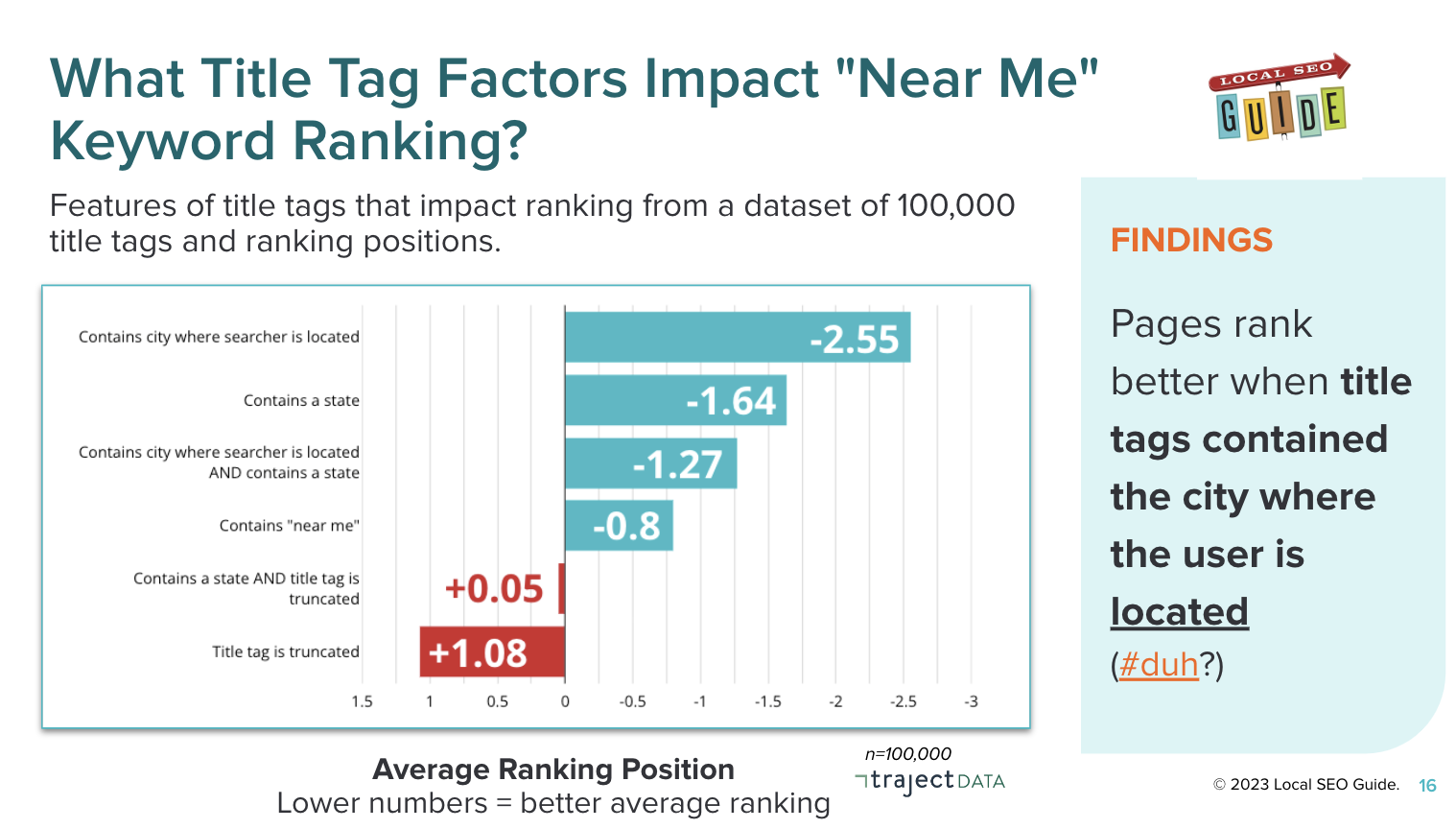 Image from author, May 2023
Image from author, May 20235. Engagement Intangibles
“Engagement” is one of the fuzzier of the many fuzzy SEO factors.
So think about what else a potential customer might need to find a location page useful.
Calls-to-action (CTAs), like the ability to make online appointments, order something online, etc., likely send positive signals to Google about the usefulness of the location page.
6. Advanced Location Page SEO
This isn’t rocket science, so when I say “advanced,” I really mean “SEO tactics for someone who somehow got buy-in from the rest of the org to prioritize updates to the location pages that everyone forgot we even had.”
Here are some things we have seen work over time. Your mileage may vary, of course:
Optimized Copy
It’s perfectly fine to start with a basic copy block with a find and replace for the location name/city that explains what your business offers.
It’s relatively cheap and easy, and you can always go back and update the copy later. See what that gets you before spending more time or money on it.
That said, we tend to see more targeted copy outperform instances of using the same copy on each page. I recall a client site not moving in rankings for six months until we updated the copy on the location pages to be unique.
As with everything SEO, try to test this at a small scale before you make a bigger investment.
Hopefully, it goes without saying, but I’ll say it: using phrases relevant to the topic you are targeting in your copy couldn’t hurt.
Certain businesses may also benefit from adding “Points of Interest” (aka “POIs”) to the copy. For example, people often search for hotels with modifiers like “near the airport.”
So adding those phrases and POIs to your location pages can make your page more relevant for these queries while also improving the relevance for the target city “entity.”
That’s a fancy way of saying that because you mention JFK Airport, Google may think you’re relevant to the great borough of Queens, NY. Mentioning the neighborhoods you serve is also a good one.
Link To Nearby Locations
Multi-location businesses should link to nearby locations (the distance depends on what you think is best for customers) from their location pages.
There are two good reasons besides customer convenience to do this:
- The more locations you have, the harder it is for Googlebot to find them, so linking to them from these pages creates more reasons for Googlebot to crawl them.
- Adding the other location names to the copy of the location page may make it more relevant for Google. For example, if there’s a link to “Starbucks Livermore” on the “Starbucks Pleasanton” page, the phrase “Livermore” might give Google more confidence about the Pleasanton location, since Livermore is the next town over.
Use Topically Relevant Images And Videos
Since these lowly location pages get no respect to begin with, they often are launched with copy only.
But check this out: We have found that for some niches, merely adding relevant images to the pages can help with ranking improvements.
For example, if you have a truck driver school, consider adding a picture of a person driving a truck (#duh3). If you are a remodeler, maybe add some shots of recent projects.
A good rule of thumb is to look at the top-ranking pages in the Local Pack for your query and make sure you have just as good, if not better, images and/or videos on your location page.
Use Google’s Vision API to ensure it understands what your image is about.
Link To Product/Service Category Pages
Last year we looked at Local Packs across 10,000,000 keywords for 40 ecommerce categories in 5,000 U.S. markets (the things we do for SEO…).
One of our key findings was that location pages that linked to category pages (e.g., Target.com’s Dublin, CA page linking to its Video Games Category Page) tended to outrank those sites that didn’t do this.
This simple tactic can have a significant impact.
Pick the categories you want to prioritize and link away.
Add Local Reviews
Adding a feed of customer reviews to these pages, particularly if the reviews are from the page’s target area, can often improve performance.
One of my theories is that a regularly updated review feed gives Google a good reason to visit the page often and prioritize it.
Before you implement this, be sure to bone up on Google’s guide to user reviews and its rules for marking up “self-serving” reviews.
Note: I have rarely seen a site penalized for violating these rules, but you may not want to be Patient Zero on this one.
Meet The Team!
We recently did a project for a moving company where we observed that many of the best-ranking pages in their markets had pictures of the local team.
According to my friend Carrie Hill of Sterling Sky,
“Any time someone goes into a client’s house, car, or business, I advise putting employee faces on websites, confirmations, and reminders.”
The Kitchen Sink
Other items that could make sense on your location pages and improve engagement include:
- Philanthropy and community connections.
- Local sponsorships.
- Hiring and careers info.
- Pricing info (marked up with Price schema, of course).
- Business license/insurance info.
- Social proof and trust signals like BBB accreditation for each location and/or “Voted Best Boba Shop in Pleasanton!”
Use Google Merchant Center Data To Increase Conversions
If you are running product listing ads (PLAs) you likely have a ton of data in Google Merchant Center that can give you hints on how to improve conversions on your location pages.
The TL;DR: Check your Google Merchant Center (GMC) to see what products get the highest impressions and click-through rate (CTR) when they are connected to your GBP in the SERPs.
This can be found in the “Local Surfaces” report. These products should be featured on the relevant location page.
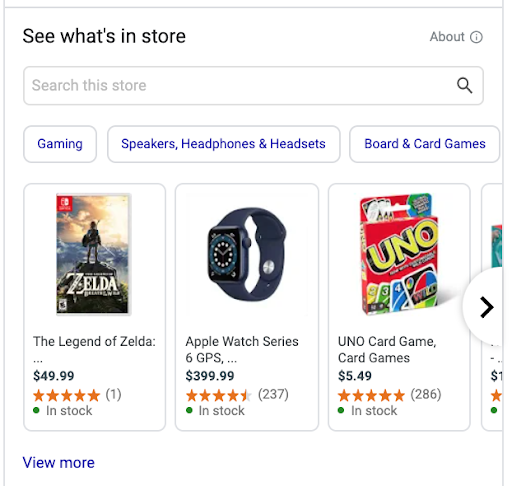 Screenshot from Google, May 2023
Screenshot from Google, May 2023Google is showing you that people are already interested in them.
See Google Merchant Center: A Local SEO Goldmine for Retailers for more detail on this wacky trick.
7. What Should I Not Do With Location Pages?
Over the past decade or two, we have tried pretty much everything you can think of with these things. Here are a couple of things you’ll want to be wary of:
Unnecessary Location + Service Pages
We’ve seen many brands launch location + service/department pages linked off the location detail page. For example, Home Depot has these pages for Home Services, Truck Rental, and its Garden Centers.
There are plenty of good non-SEO reasons to have these pages. If you are looking to rent a truck, having a specific page about renting a truck in your city might be helpful.
But be clear that this will often not be a net-new traffic play.
Why do I say this?
Because, after looking at organic traffic data to tens of thousands of location + service pages, we have observed that most of the time, 90% of the organic traffic to these pages is brand traffic, and they are likely cannibalizing searches you were already getting.
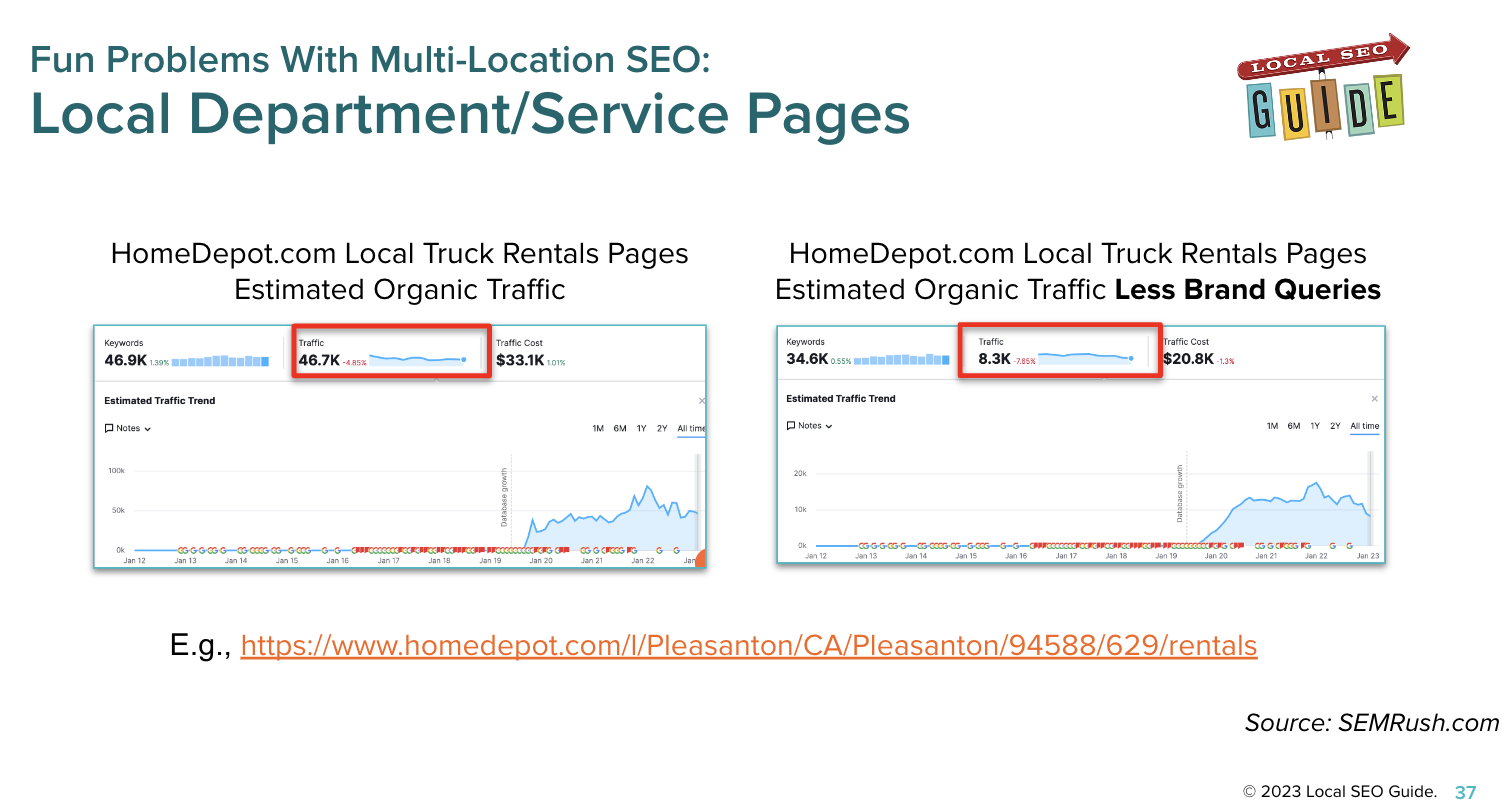 Image from Semrush, May 2023
Image from Semrush, May 2023This is not the case in every situation, and it may be worth it to roll these out merely to improve conversions.
But you should be aware that these may not be a net positive in terms of organic traffic, and they may even have negative SEO effects due to increasing the number of “thin” URLs on the site.
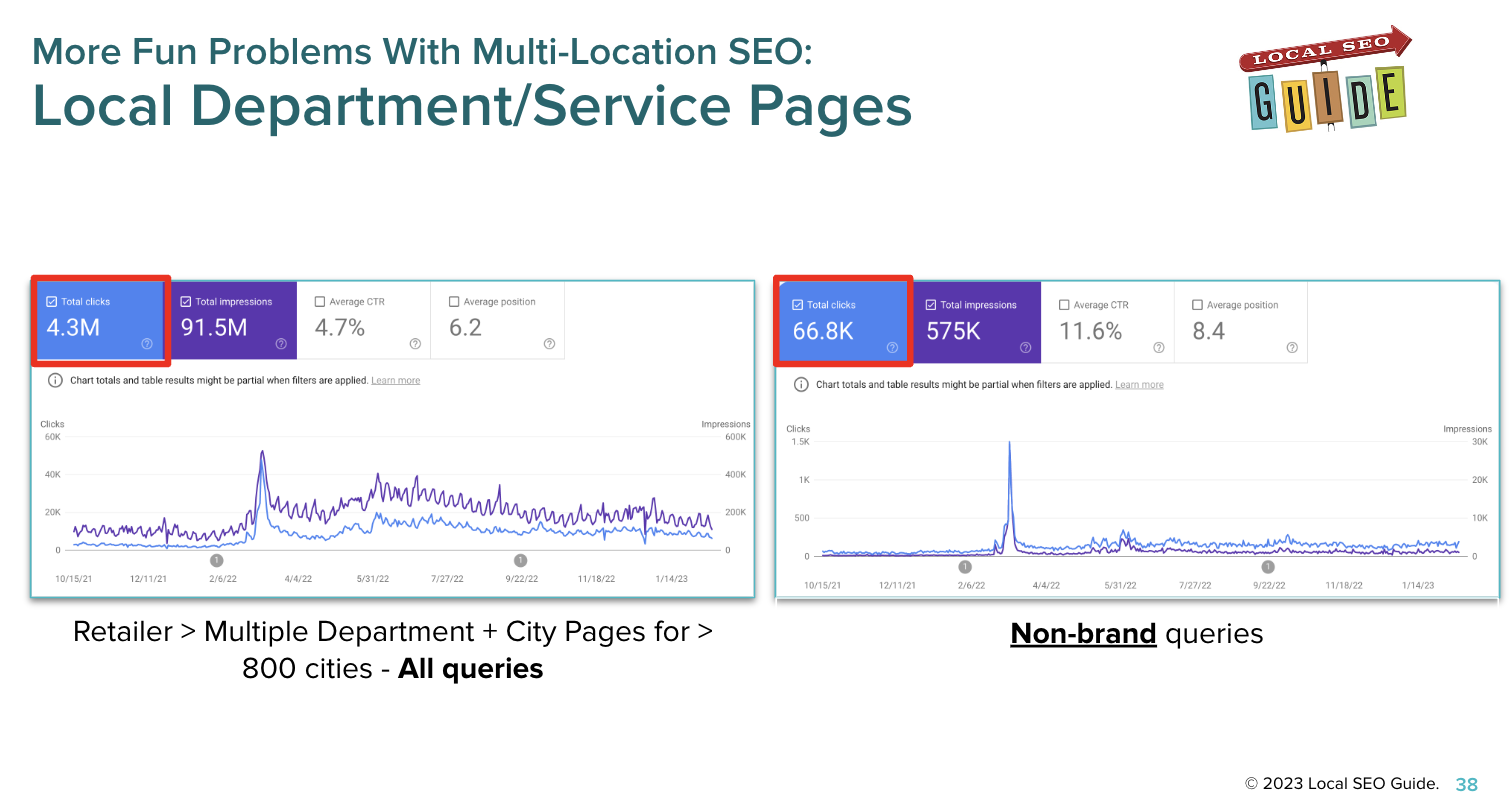 Image from Semrush, May 2023
Image from Semrush, May 2023In one case, we had a client with about 100,000 URLs launch these pages, which created about 1,000,000 new URLs. Guess how well that went.
Our rule of thumb is that if a department or service can get a GBP, it may be worth creating a local page for SEO purposes. This doesn’t apply to all cases, of course.
Location Pages With No Location
We recently worked on a retailer site that created pages for cities that were near their locations, but where they had no locations.
The pages looked like every other location page, but instead of presenting NAP info for a relevant location, it linked to the nearby locations.
This was a national site, so they had over 130,000 of these. And, of course, they were getting virtually zero organic traffic.
For SABs, this tactic is necessary if you want to rank outside of your physical location’s area (more on that in a moment). But it seems that, for queries that imply a searcher is looking for a physical location, Google doesn’t want to show you these types of no-location pages.
Oh, and don’t add insult to injury by creating local pages for every brand you carry (e.g.,/ca/pleasanton/flaming-hot-cheetohs). This client had about 500,000 of those and, you guessed it, virtually no organic traffic.
Beware Thin Content Location Pages
A common tactic for service area businesses or SABs is to create a ton of location pages for the areas they serve.
They may even make the content on them super unique.
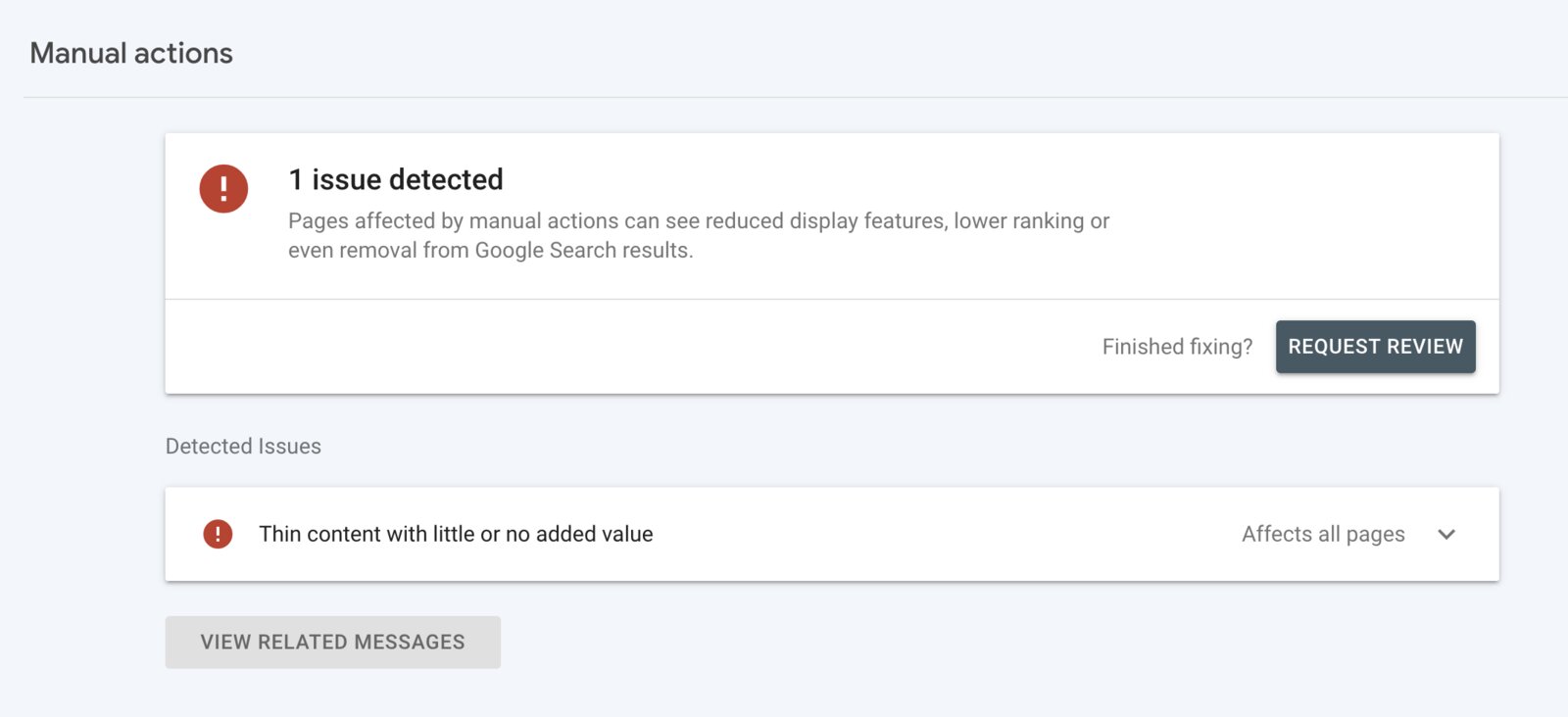 Screenshot from Google Search Console, May 2023
Screenshot from Google Search Console, May 2023The challenge is that we are starting to see these types of plays get manual actions for thin content.
Of course, Google does not seem to apply this across the board. I still see plenty of “thin” location pages for various queries.
So what can you do? It’s the same challenge every other SEO has.
Look at what type of content is doing best for a particular query type and create a better page. Let’s face it: when it comes to location pages, the bar is pretty low.
Only Create Pages When There Is Clear Local Intent
We just finished up a project for an attorney with practices in 30+ cities. They have 54 practice areas and have created location + practice pages for each. That’s 1,620+ pages for Google to figure out.
The first thing we did was to determine how much “local intent” there was for search results for each practice area.
“Local intent” can be determined by what % of a SERP has “local” content (e.g., Local Packs, cities or states in the titles, suggested or related searches, etc.).
You don’t need a location page for a query with relatively low local intent. This particular attorney had 300+ location pages targeting queries that had no local intent.
In these cases, it would be better for SEO to redirect these pages to a single “national” service page.
So before you invest a lot in creating location pages, check for local intent first. It might save you a lot of time and cash.
I could keep going.
These deceptively simple pages have near-infinite possibilities for SEO, but my guess is that if you have made it this far, you now have plenty of JIRA tickets to prioritize.
Gunga galunga.
Special thanks to Carrie Hill, Amy Toman, Mike Blumenthal, Joy Hawkins, Brandon Schmidt, and Will Scott for providing feedback.
Special thanks to the LSG team for yelling at me like they were my mother when I was procrastinating while writing this article.
More resources:
Featured Image: DEEMKA STUDIO/Shutterstock
SEO
Google Declares It The “Gemini Era” As Revenue Grows 15%

Alphabet Inc., Google’s parent company, announced its first quarter 2024 financial results today.
While Google reported double-digit growth in key revenue areas, the focus was on its AI developments, dubbed the “Gemini era” by CEO Sundar Pichai.
The Numbers: 15% Revenue Growth, Operating Margins Expand
Alphabet reported Q1 revenues of $80.5 billion, a 15% increase year-over-year, exceeding Wall Street’s projections.
Net income was $23.7 billion, with diluted earnings per share of $1.89. Operating margins expanded to 32%, up from 25% in the prior year.
Ruth Porat, Alphabet’s President and CFO, stated:
“Our strong financial results reflect revenue strength across the company and ongoing efforts to durably reengineer our cost base.”
Google’s core advertising units, such as Search and YouTube, drove growth. Google advertising revenues hit $61.7 billion for the quarter.
The Cloud division also maintained momentum, with revenues of $9.6 billion, up 28% year-over-year.
Pichai highlighted that YouTube and Cloud are expected to exit 2024 at a combined $100 billion annual revenue run rate.
Generative AI Integration in Search
Google experimented with AI-powered features in Search Labs before recently introducing AI overviews into the main search results page.
Regarding the gradual rollout, Pichai states:
“We are being measured in how we do this, focusing on areas where gen AI can improve the Search experience, while also prioritizing traffic to websites and merchants.”
Pichai reports that Google’s generative AI features have answered over a billion queries already:
“We’ve already served billions of queries with our generative AI features. It’s enabling people to access new information, to ask questions in new ways, and to ask more complex questions.”
Google reports increased Search usage and user satisfaction among those interacting with the new AI overview results.
The company also highlighted its “Circle to Search” feature on Android, which allows users to circle objects on their screen or in videos to get instant AI-powered answers via Google Lens.
Reorganizing For The “Gemini Era”
As part of the AI roadmap, Alphabet is consolidating all teams building AI models under the Google DeepMind umbrella.
Pichai revealed that, through hardware and software improvements, the company has reduced machine costs associated with its generative AI search results by 80% over the past year.
He states:
“Our data centers are some of the most high-performing, secure, reliable and efficient in the world. We’ve developed new AI models and algorithms that are more than one hundred times more efficient than they were 18 months ago.
How Will Google Make Money With AI?
Alphabet sees opportunities to monetize AI through its advertising products, Cloud offerings, and subscription services.
Google is integrating Gemini into ad products like Performance Max. The company’s Cloud division is bringing “the best of Google AI” to enterprise customers worldwide.
Google One, the company’s subscription service, surpassed 100 million paid subscribers in Q1 and introduced a new premium plan featuring advanced generative AI capabilities powered by Gemini models.
Future Outlook
Pichai outlined six key advantages positioning Alphabet to lead the “next wave of AI innovation”:
- Research leadership in AI breakthroughs like the multimodal Gemini model
- Robust AI infrastructure and custom TPU chips
- Integrating generative AI into Search to enhance the user experience
- A global product footprint reaching billions
- Streamlined teams and improved execution velocity
- Multiple revenue streams to monetize AI through advertising and cloud
With upcoming events like Google I/O and Google Marketing Live, the company is expected to share further updates on its AI initiatives and product roadmap.
Featured Image: Sergei Elagin/Shutterstock
SEO
brightonSEO Live Blog

Hello everyone. It’s April again, so I’m back in Brighton for another two days of Being the introvert I am, my idea of fun isn’t hanging around our booth all day explaining we’ve run out of t-shirts (seriously, you need to be fast if you want swag!). So I decided to do something useful and live-blog the event instead.
Follow below for talk takeaways and (very) mildly humorous commentary. sun, sea, and SEO!
SEO
Google Further Postpones Third-Party Cookie Deprecation In Chrome

Google has again delayed its plan to phase out third-party cookies in the Chrome web browser. The latest postponement comes after ongoing challenges in reconciling feedback from industry stakeholders and regulators.
The announcement was made in Google and the UK’s Competition and Markets Authority (CMA) joint quarterly report on the Privacy Sandbox initiative, scheduled for release on April 26.
Chrome’s Third-Party Cookie Phaseout Pushed To 2025
Google states it “will not complete third-party cookie deprecation during the second half of Q4” this year as planned.
Instead, the tech giant aims to begin deprecating third-party cookies in Chrome “starting early next year,” assuming an agreement can be reached with the CMA and the UK’s Information Commissioner’s Office (ICO).
The statement reads:
“We recognize that there are ongoing challenges related to reconciling divergent feedback from the industry, regulators and developers, and will continue to engage closely with the entire ecosystem. It’s also critical that the CMA has sufficient time to review all evidence, including results from industry tests, which the CMA has asked market participants to provide by the end of June.”
Continued Engagement With Regulators
Google reiterated its commitment to “engaging closely with the CMA and ICO” throughout the process and hopes to conclude discussions this year.
This marks the third delay to Google’s plan to deprecate third-party cookies, initially aiming for a Q3 2023 phaseout before pushing it back to late 2024.
The postponements reflect the challenges in transitioning away from cross-site user tracking while balancing privacy and advertiser interests.
Transition Period & Impact
In January, Chrome began restricting third-party cookie access for 1% of users globally. This percentage was expected to gradually increase until 100% of users were covered by Q3 2024.
However, the latest delay gives websites and services more time to migrate away from third-party cookie dependencies through Google’s limited “deprecation trials” program.
The trials offer temporary cookie access extensions until December 27, 2024, for non-advertising use cases that can demonstrate direct user impact and functional breakage.
While easing the transition, the trials have strict eligibility rules. Advertising-related services are ineligible, and origins matching known ad-related domains are rejected.
Google states the program aims to address functional issues rather than relieve general data collection inconveniences.
Publisher & Advertiser Implications
The repeated delays highlight the potential disruption for digital publishers and advertisers relying on third-party cookie tracking.
Industry groups have raised concerns that restricting cross-site tracking could push websites toward more opaque privacy-invasive practices.
However, privacy advocates view the phaseout as crucial in preventing covert user profiling across the web.
With the latest postponement, all parties have more time to prepare for the eventual loss of third-party cookies and adopt Google’s proposed Privacy Sandbox APIs as replacements.
Featured Image: Novikov Aleksey/Shutterstock
-

 PPC7 days ago
PPC7 days ago19 Best SEO Tools in 2024 (For Every Use Case)
-
SEARCHENGINES6 days ago
Daily Search Forum Recap: April 19, 2024
-
SEARCHENGINES7 days ago
Daily Search Forum Recap: April 18, 2024
-

 WORDPRESS6 days ago
WORDPRESS6 days agoHow to Make $5000 of Passive Income Every Month in WordPress
-

 WORDPRESS5 days ago
WORDPRESS5 days ago13 Best HubSpot Alternatives for 2024 (Free + Paid)
-

 SEO7 days ago
SEO7 days ago25 WordPress Alternatives Best For SEO
-

 WORDPRESS6 days ago
WORDPRESS6 days ago7 Best WooCommerce Points and Rewards Plugins (Free & Paid)
-

 MARKETING6 days ago
MARKETING6 days agoBattling for Attention in the 2024 Election Year Media Frenzy













